#barong tagalog for men
Explore tagged Tumblr posts
Text


The Metropolitan Museum of Art






youtube
246 notes
·
View notes
Text
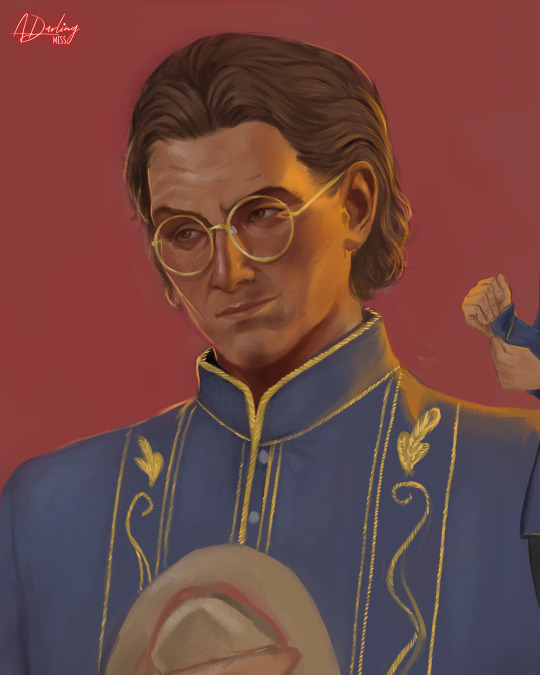
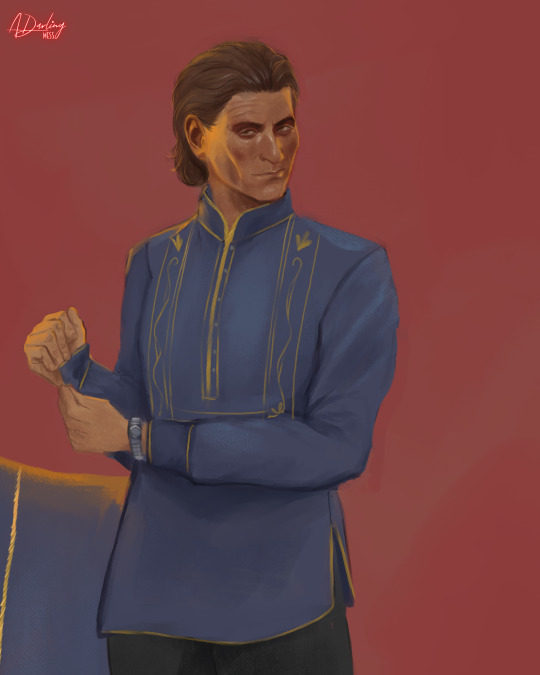

"𝐀𝐭 𝐢𝐲𝐨𝐧, 𝐬𝐢𝐧𝐭𝐚, 𝐚𝐧𝐠 𝐰𝐚𝐤𝐚𝐬."
Raphael in a Barong Tagalog, a traditional Filipino garment worn by men on formal occasions!
Mr. Wincott attempting to say the Filipino translation of "And that, love, was that" urged me to draw this!
131 notes
·
View notes
Text
Another entry for Filipino related stuff for Grindeldore! (FINALLY)
Barong tagalog & Kundiman
baro means “upper garment” -> “Tagalog outfit”



It is an traditional dress shirt worn by Filipino native men during the Spaniards. It's a very thin light but stiff fabric-long sleeve garment that is worn loose and over an undershirt then tucked in the trousers.You can have its designed embroidery vary from leaves, branches, flowers, animals, ethnic patterns, family crests, etc.
For Albus' barong, it has the traditional Pechera or front chest shirt design resembling a phoenix and celestial bodies.
For Gellert's barong, I op for Batok or nape designs that extends to his sleeves that's embroidered with the deathly hallows, lavenders and ridiculously detailed leaves that I may never try again-
Here's the original concept from paper!
Kundiman
comes from the Tagalog phrase “kung hindi man” or “if it were not so”. Written in the Tagalog language, these folksongs were subtly patriotic but typically disguised as love songs...
English translation of the lyrics:
The sign of my chest, O beloved...
Tastes bitter, sweet, and pain upon your lips...
My lover from the moon, I shall continue to be enkindled by you...
As we continue the dance of life...
#Grindeldore fil week#Grindeldore#GGAD#Apicelladonna's Art!#Albus Dumbledore#Gellert Grindelwald#fbawtft#happy fucking buwan ng wika yall#dumbledore x grindelwald#gelbus#hp art#hp fanart#fantastic beasts art#artists on tumblr#digital artist#small artist#illustration
18 notes
·
View notes
Note
Agent Phoenix, upon finding out they will meet Chancellor Magpantay, wore a barong (also known as a barong tagalog).
(While it is traditionally worn by men, who's really stopping them? Also, the fabric is apparently cool on the skin, perfect for the warm climate.)
.
7 notes
·
View notes
Text
19th Century Philippines Clothing (Upper Class)
Featuring William Shakespeare (Ikemen Vampire) and Auburn (@azulashengrottospiano)
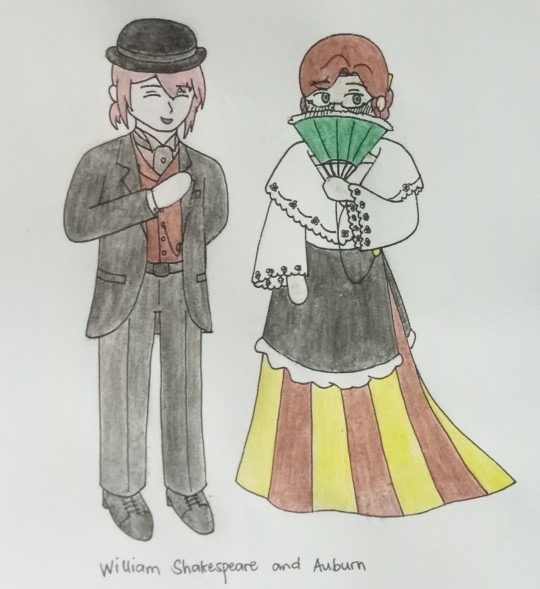
Full photo:
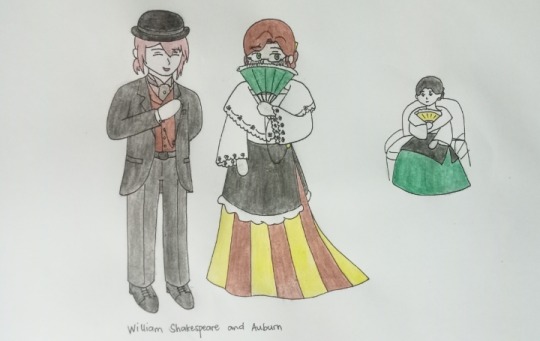
Just a guy from overseas visiting his ladylove 🤭
Fun facts:
– The traje de mestiza (translation: mestiza's gown), popularly known as the Maria Clara gown, is a type of traditional clothing in the Philippines worn by the upper-class Filipino women during the Spanish colonial era. It got it's name from Maria Clara, the heroine of the novels Noli Me Tangere and El Filibusterismo by Dr. Jose Rizal.
The camisa (blouse) and pañuelo or alampay (neckerchief) are made of piña, a type of fabric made from pineapple leaves' fibres. The saya (skirt) and the tapis (overskirt) are made of more opaque material like cotton or silk. Brocade and Jacquard fabrics are also used to make saya skirts worn by the upper-class women.
– Women at the time accessorize themselves by wearing peineta or payneta (decorative hair comb), necklaces, earrings, and abanikos (hand fans).
– Men who studied overseas (also called as Ilustrados, meaning "enlightened ones") are usually shown in photographs wearing late Victorian-style clothing. Upper-class Filipino men who lives in the Philippines during the 19th century wear barong tagalog which is also made of piña cloth. Canes are also a symbol of wealth amongst the upper class.
– Unmarried women are not allowed to meet a man alone without an older female relative watching over them. This is to ensure that the pair will not do something that is against the customs of the time (will elaborate on the next bullet).
– Unmarried couples are not allowed to hold each other, let alone kiss each other (kinda forgot but I think it has something to do with keeping a lady's purity until marriage or something).
If a man accidentally kissed an unmarried woman, he must take responsibility for it and marry her.
That's pretty much it! I had fun drawing these two— er, three, if the lady in the background is counted.
#can you even consider this an au? maybe??#cookie's art/doodles#ikemen vampire#ikevamp#ikemen vampire fanart#ikevamp fanart#ikevamp shakespeare#ikemen vampire shakespeare#19th century Philippine clothing
14 notes
·
View notes
Text
Sharing personal narratives during Filipino American History Month is a powerful way to honor and celebrate Filipino heritage while also fostering a deeper connection to one’s roots and identity. Here are some meaningful approaches to sharing your Filipino American heritage:

1. Family Stories and Traditions
Highlight Generational Journeys: Share the stories of your ancestors or parents who immigrated to the U.S. What motivated them to leave the Philippines, and what challenges did they face in adapting to a new culture? Exploring these journeys allows others to appreciate the resilience of Filipino immigrants.
Cultural Traditions: Discuss the customs and traditions that have been passed down through your family, such as celebrations of Pasko (Christmas), fiestas, or rituals like Simbang Gabi. Share how your family balances Filipino traditions with life in America.
2. Struggles and Achievements as a Filipino American
Navigating Dual Identities: Many Filipino Americans grow up balancing two cultures—American and Filipino. Sharing how you’ve navigated this identity can resonate with others who may have similar experiences of being bicultural.
Facing Discrimination and Finding Empowerment: Talk about any challenges you’ve faced, such as racial discrimination or feeling like an outsider. Sharing how you overcame these struggles, found empowerment, or connected with the Filipino American community can be inspiring.
3. The Role of Filipino Values
Values like Bayanihan and Kapwa: Filipino culture is deeply rooted in values like bayanihan (community spirit) and kapwa (shared humanity). Share stories of how these values were instilled in you and how they have influenced your life in America. Have you seen these values in action in your own community?
Respect for Elders: The concept of utang na loob (debt of gratitude) and pakikisama (getting along with others) are strong values in Filipino culture. Reflecting on how these values have shaped your relationships with family and friends can open up meaningful dialogue.
4. Food as a Cultural Bridge
Exploring Filipino Cuisine: Food is one of the most accessible ways to share heritage. Talk about the dishes your family loves to cook or the meals you grew up with, such as adobo, lumpia, sinigang, or lechon. Hosting a gathering or sharing recipes can be a fun and engaging way to introduce others to Filipino culture.
Food and Storytelling: Food often serves as a bridge to deeper conversations. Share a story about a particular dish, its significance, and how it connects you to your heritage.
5. Contribution to American Society
Highlight Filipino American Achievements: Whether it’s sharing the stories of Filipino labor leaders like Larry Itliong or the contributions of Filipino World War II veterans, remind others of the long history of Filipino Americans in shaping the country.
Your Own Impact: Discuss your personal achievements and how your Filipino heritage has influenced your work or contributions to society. Whether you are involved in education, healthcare, technology, or any field, your story adds to the rich tapestry of Filipino American history.
6. The Power of Art and Music
Creative Expression: If you are an artist, musician, or writer, use your platform to express your heritage. Through dance (such as Tinikling or Binasuan), music, poetry, or visual art, you can share aspects of Filipino culture while connecting with diverse audiences.
Filipino American Artists: Reflect on the work of Filipino American creatives who have inspired you, from authors like Carlos Bulosan to contemporary filmmakers and musicians.
7. Engaging in Social Media and Public Talks
Social Media Campaigns: Use social media to share your narrative with a broader audience. Creating posts, videos, or blogs during Filipino American History Month can help educate others on the rich diversity of the Filipino American experience.
Speaking at Community Events: Volunteer to speak at schools, universities, or community centers. Sharing your story publicly can inspire others to reflect on their own heritage and embrace their cultural identity.
8. Connecting with Filipino American Communities
Attending Cultural Events: Participate in or organize events within your local Filipino American community. Storytelling circles, cultural festivals, or panel discussions are great ways to share your personal narrative and learn from others.
Mentorship and Youth Involvement: Sharing your story with younger generations can be impactful. Encourage young Filipino Americans to be proud of their heritage and pass on the importance of understanding their roots.
By sharing your personal narratives, you are contributing to the broader Filipino American story and helping preserve the legacy of a resilient and dynamic community. It’s also a way to celebrate identity, create solidarity, and ensure that the unique experiences of Filipino Americans are not forgotten.
#barongtagalog#philippines#barongs#philippine culture#custommadebarongtagalog#filipinopride#madeinthephilippines#filipinoculture#filipinowedding#pinoy#filipinostyle#pinoyshoppingonline#Custommadebarongtagalog#pinoyshopping#kimonadress#FilipinoWeddingDress
2 notes
·
View notes
Text

My son, Gavin, and his lovely new wife, Gabby ♥️

The bridal party changed when we got to the restaurant. I think I was the only one who kept his Barong shirt on. 😂
The barong tagalog, more commonly known simply as barong (and occasionally baro), is an embroidered long-sleeved formal shirt for men and a national dress of the Philippines. Barong tagalog combines elements from both the precolonial native Filipino and colonial Spanish clothing styles.
3 notes
·
View notes
Note
Hey man, while I'm happy you like my original THSC characters it's kinda been making me uncomfortable seeing them in your AU without asking for my permission. Especially in a Nazi(?) AU? I don't know much about this game that you crossed with THSC but I heard it's very historically detailed.
To be upfront, I'd appreciate it if my OCs were excluded. I'm sorry, I hope I don't sound rude or something I just haven't really had the guts to say anything.
Yo, I understand that you may not like it. The reason why I don't ask permission is because it adds up to the surprise of imitating a certain artstyle for that blog. To honor your request, I'll exclude your OC's in any future crossover drawings (if your fine with letting me do so if I have the permission, then I'll limit the themes to just the "wholesome" parts). As a gift of appreciation for bringing this up, I've gotten the time to draw Brutus in a Barong Tagalog, a formal shirt and national dress (for men) in the Philippines.

4 notes
·
View notes
Note
Imagine how confusing/exciting it must be for Philippine's myth transient when they met Barong. They probably switch to Tagalog out of excitement.
Right like wait you aren't the traditional filipino clothing for men?
3 notes
·
View notes
Text

"Timawa" were free people in ancient Filipino society, different from nobles and slaves. They did not serve as slaves but also had no royal status. They could own land, join battles, and live independently. Timawa had more freedom than slaves but still had to serve the ruling class sometimes.

"Ladino" were Filipinos during Spanish rule who could speak both Spanish and their native language. They acted as translators and writers, helping Filipinos and Spaniards communicate. Many Ladinos wrote early Filipino literature and spread knowledge. They were important in history because they helped preserve Filipino culture while learning Spanish ways.

"Traditional clothing" refers to the special clothes worn by people in the past or during cultural events. In the Philippines, examples include the Barong Tagalog for men and the Baro't Saya for women. These outfits show Filipino identity, history, and traditions, often worn at weddings, festivals, and formal gatherings.

"Oral tradition" is the way stories, history, and knowledge are passed from one generation to another by speaking instead of writing. It includes folktales, myths, songs, and proverbs. Many cultures use oral tradition to teach lessons, share beliefs, and keep their history alive before written records existed.

"Democracy" is a system of government where people have the power to choose their leaders through voting. In a democracy, everyone has rights and can express their opinions. Leaders are responsible for listening to the people. This system promotes fairness, freedom, and equality in decision-making for a country or community.
0 notes
Text
“The Ultimate Guide to Pinoy Fashion and Trends” would definitely be a great way to explore the diverse, dynamic world of Filipino style! Here’s a breakdown of key themes and elements that make Pinoy fashion stand out:

1. Traditional Filipino Wear
Barong Tagalog: This iconic piece for men, often made from lightweight fabrics like piña or jusi, is a blend of elegance and cultural significance. The women’s counterpart, the Baro’t Saya (or Filipiniana), offers a graceful silhouette with a variety of fabric choices.
Filipiniana Gowns: For women, the Filipiniana offers a fusion of European and Filipino elements, especially in formal settings. Its signature butterfly sleeves are always a classic touch.
Terno: Known for its structured silhouette, the Terno is often worn for formal events and is recognized by its dramatic butterfly sleeves.
2. Contemporary Filipino Fashion
Streetwear & Street Style: Filipino youth have embraced streetwear culture, with local brands merging international trends with Filipino flair. Graphic tees, sneakers, and caps are common, often reflecting pride in Filipino heritage through national symbols or quirky takes on Filipino pop culture.
Sustainable Fashion: Filipino designers are increasingly turning towards eco-friendly and sustainable materials. This trend emphasizes the use of local, organic textiles like abaca (banana fiber), t’nalak (woven fabric from the T’boli tribe), and piña fabric.
Fashion Collaborations: Local designers collaborate with international names, creating a fusion of global and local designs, and promoting Filipino craftsmanship abroad.
3. Filipino Textile Innovation
Piña Fabric: A traditional fabric made from pineapple fibers, it’s lightweight, elegant, and often used for formalwear like the Barong or Filipiniana. Its delicate nature gives it a unique texture and visual appeal.
Abel Fabric: This handwoven textile from the Ilocos region is known for its durability and bright, geometric patterns. It’s becoming a popular choice for modern designers, who incorporate it into contemporary pieces like jackets and bags.
Banig Weaving: Made from woven palm leaves, banig has transformed into a fashion statement, from accessories to bags and shoes.
4. Local Fashion Designers
Ramon Valera: A National Artist of Fashion Design, Valera is known for making the Terno a global fashion statement. His pieces celebrate traditional Filipino craftsmanship.
Rajo Laurel: A household name in modern Filipino fashion, Laurel mixes traditional elements with contemporary chic, making him a top designer in the Philippines and internationally.
Francis Libiran: Known for his high-end creations, Libiran often uses piña and other indigenous textiles in his glamorous pieces.
5. Filipino Fashion Icons and Influencers
Anne Curtis, Heart Evangelista, and Pia Wurtzbach are just a few celebrities who showcase Filipino talent through their red carpet and casual fashion looks.
Social Media Influencers like Camille Co, Laureen Uy, and Liza Soberano help shape the modern Pinoy fashion landscape, often blending Filipino craftsmanship with global trends.
6. Filipino Fashion in Global Runways
Filipino designers are becoming more visible on the global fashion stage. Events like Manila Fashion Festival and Philippine Fashion Week continue to show the world how the local fashion scene is thriving with modern flair while staying deeply connected to cultural roots.
7. Cultural and Regional Influences
Mindanao: Many fashion designers are drawing inspiration from Mindanao’s indigenous groups, incorporating tribal patterns, woven fabrics, and unique color schemes into contemporary designs.
Visayas and Luzon: Traditional garments and textiles from different islands influence a variety of local designs, from intricate embroidery in the Visayas to bold prints and vivid colors from the Ilocos region.
8. Festivals and Fashion
Pahiyas Festival (Quezon) and Sinulog Festival (Cebu): These festivals are not only vibrant in their celebrations but also showcase elaborate, colorful costumes and fashion expressions.
Barong-inspired Designs: For men, modern takes on the Barong—such as casual button-down versions made from natural fabrics—are popular during festive seasons, especially for weddings or special events.
9. The Influence of Filipino Pop Culture
K-Pop and Western Fashion: The Filipino youth have been greatly influenced by K-Pop culture, often blending it with Filipino sensibilities. Bright colors, bold prints, and fun accessories are common in this cross-cultural style.
“Filipiniana Remix”: Designers are also reimagining the Filipiniana gown with modern twists—experimenting with silhouettes, colors, and fabric choices.
This guide could serve as a comprehensive resource for those interested in Filipino fashion. Whether you’re celebrating Filipino culture through traditional pieces or looking to explore the future of local fashion trends, there’s always something to discover.
What part of Pinoy fashion interests you the most? Are you into modern trends or traditional pieces, or maybe a bit of both?
#barong tagalog#philippines#barong#pinoy#philippines fashion#barongtagalog#barongtagalogforwomen#womensfashion#shopping#barongs
0 notes
Text
Men's native wears,
Men's native wears,
Men’s native wears are more than just garments; they are a vibrant expression of culture, identity, and heritage. Across various cultures, traditional attire plays a significant role in preserving customs, celebrating occasions, and showcasing the artistry of indigenous craftsmanship. Let’s dive into the world of men’s native wears, exploring their styles, significance, and timeless appeal.
The Significance of Native Wears
Native wears often carry deep cultural and historical meanings. They reflect the values, traditions, and artistic sensibilities of the communities they originate from. For men, these outfits symbolize strength, dignity, and respect for their heritage. Whether worn for ceremonial purposes, festive celebrations, or daily life, native wears connect individuals to their roots and tell stories of generations past.
Popular Styles of Men’s Native Wears
1. Agbada (West Africa)
The Agbada is a flowing, wide-sleeved robe worn predominantly in Nigeria and other parts of West Africa. Made from richly embroidered fabrics like Aso Oke, lace, or brocade, Agbada exudes elegance and is often reserved for special occasions such as weddings and traditional ceremonies.
2. Kanzu (East Africa)
In East Africa, particularly in Uganda and Tanzania, men wear the Kanzu, a long white or cream tunic. This attire is often paired with a blazer or jacket for formal occasions, symbolizing simplicity and dignity.
3. Kurta (South Asia)
The Kurta is a versatile garment worn in countries like India, Pakistan, and Bangladesh. It is a knee-length shirt often paired with trousers or dhotis. Kurtas come in various fabrics and designs, ranging from simple cotton for casual wear to intricately embroidered silk for festive events.
4. Dashiki (West Africa)
The Dashiki is a colorful, loose-fitting shirt featuring bold patterns and intricate embroidery. Originating from West Africa, it has become a global symbol of African pride and identity, often worn at cultural festivals and informal gatherings.
5. Barong Tagalog (Philippines)
The Barong Tagalog is a traditional Filipino shirt made from lightweight materials such as piña or jusi fabric. Known for its sheer texture and delicate embroidery, it is often worn during formal occasions like weddings and national celebrations.
Contemporary Trends in Men’s Native Wears
In recent years, native wears have undergone a modern transformation, blending traditional designs with contemporary fashion. Designers worldwide are incorporating native motifs, fabrics, and styles into mainstream fashion, creating a unique fusion of old and new. This trend not only celebrates cultural diversity but also makes native wears more accessible and appealing to younger generations.
Some notable trends include:
Custom Tailoring: Personalized fits and designs that enhance comfort and style.
Fusion Styles: Combining native elements with Western outfits, such as pairing a Dashiki with jeans or a Kurta with sneakers.
Eco-Friendly Fabrics: Using sustainable and organic materials to honor traditional weaving techniques while promoting environmental responsibility.
Choosing the Perfect Native Wear
When selecting native wear, consider the occasion, cultural significance, and personal style. Opt for high-quality fabrics and authentic designs to honor the tradition behind the attire. Accessories such as hats, beads, and footwear can further enhance the look and add a touch of individuality.
Conclusion
Men’s native wears are a celebration of cultural identity, craftsmanship, and timeless elegance. They bridge the gap between tradition and modernity, allowing men to express their heritage with pride. Whether it’s the grandeur of an Agbada, the simplicity of a Kanzu, or the vibrancy of a Dashiki, native wears continue to inspire and captivate across generations and borders. Embracing these garments is not just about fashion—it’s about keeping traditions alive and sharing stories of culture with the world.
0 notes
Text
Learning Activity 3.5, Task 2: What Has Influenced Me?
Being raised as a Filipino-Egyptian girl, the wonderful blending of two diverse cultures has impacted my life. I was raised in the Philippines, surrounded by Filipino values, rituals, and traditions, for the first eleven years of my life. In addition, I continued to feel a strong connection to my Egyptian roots because of my family and our common cultural customs. This dual identity has changed how I see the world, inspired by both Filipino and Egyptian traditions, as well as by broader global cultures. These cultural components have meaningfully enhanced my experiences in a variety of ways, from cuisine to fashion, architecture, leisure pursuits, and entertainment.
One of the ways that culture affects my life the most directly is through food. I am quite fortunate to have been exposed to the variety of foods that celebrate both my Filipino and Egyptian ethnic heritage. While growing up in the Philippines, lechon, sinigang, and adobo were staples in our regular diet, being well known for their bold flavors. These dishes evoke fond memories from my childhood, from family gatherings to celebrations.

However, a significant part of my daily existence is Middle Eastern cuisine, which I inherited from my Egyptian heritage. I love foods like falafel, shawarma, and koshari, which is a mixture of grains, lentils, and noodles. The flavors of these meals, even though they are very different from Filipino food, are rich and aromatic because of various spices, which include cumin, coriander, and sumac. This is the fusion of Filipino and Egyptian dishes, which reflects my own path to balancing two cultures, which has also made me realize how food can bind us to our history.

Fashion: A Blend of Tradition and Modernity
In my life, fashion is a fusion of modern Egyptian and Filipino elements with classic styles. Special occasions call for the Filipinos to wear their native attires, which are barong Tagalog for men and barot saya for women. Though I don't wear these daily, the beautiful needlework and the fact that such clothes have been passed on through generations remind me of my Filipino identity.

On the Egyptian side, my relatives occasionally dress traditionally for family get-togethers or religious ceremonies, such as the loose, flowing garment known as the galabeya. Egyptian attire symbolizes the culture's emphasis on family and respect for tradition, which I find appealing. The modest yet elegant designs of the clothing speak to my ideals.

I am influenced by international fashion trends at the same time, frequently fusing Western styles with aspects of Egyptian and Filipino fashion. I can express my identity and stay true to my roots with this blend.
Architecture: The Best of Both Worlds
I also see the impact of Egyptian and Filipino cultures in architecture. Filipino architecture frequently emphasizes useful styles appropriate for tropical environments, such as nipa huts and windows with ventilation to let in natural light and keep out heat. The straightforward yet practical homes in the Philippines where I grew up, where nature is incorporated into the living space, are what these designs remind me of.

On the other hand, Egyptian architecture is renowned for its imposing buildings with elaborate geometric designs and tall minarets, such mosques and pyramids. The historical legacy of Islamic architecture in Egypt has always captivated me, and I often think on the sensation of wonder I get when I see photos of ancient Egyptian temples or visit mosques with my family.

These two architectural motifs, one based on history and grandeur and the other in nature and simplicity, each symbolize distinct aspects of my identity. When combined, they serve as a helpful reminder of how crucial it is to include other cultural viewpoints in order to have a fulfilling life.
Leisure Activities: A Cultural Balance
My leisure activities are a great mix of my Egyptian and Filipino roots. Growing up in the Philippines, I played street games customary to all Filipino kids: tumbang preso, patintero, sipa. It is through such events that I learned about two important elements in Filipino culture: community and teamwork.

I've been influenced by the great history of poetry and storytelling from my Egyptian side. Egyptian folklore stories are enjoyable to tell with my family since they frequently contain moral and wise teachings. This makes using my free time to pass on information to future generations and maintain a connection to my heritage possible.

I also like to listen to Arabic music and occasionally take part in dabke, a traditional dance from the Middle East. By doing this, I can appreciate the joy and rhythm that are ingrained in Middle Eastern culture and stay in touch with my Egyptian side.
Entertainment: A Global Perspective
My life's entertainment is a contemporary take on the global influences of Egyptian and Filipino civilizations. Variety performances and telenovelas play a significant role in the Philippine entertainment landscape. I grew up watching Filipino dramas with my family, which generally reflect themes of love, sacrifice, and family loyalty—values that are important to Filipino culture.

My Egyptian ancestry has also given me a passion for traditional Arabic cinema and music. Egyptian film, which is frequently recognized as among the most significant and ancient in the Arab world, exemplifies the depth of Arabic narrative, which has profoundly impacted my perception of societal values, tradition, and family.

Global entertainment trends, including Western movies, TV series, and music, also have an impact on me. I now have a more comprehensive understanding of life and can enjoy a wider range of stories and cultural expressions because to this combination of Filipino, Egyptian, and international media.
Conclusion: A Life Enriched by Cultural Diversity
My identity as a Filipino-Egyptian has put me in a position where I can appreciate the diversity of two very different cultures. The things I eat, the clothes I wear, or the hobbies I pursue; both Filipino and Egyptian customs influence me throughout my life. Furthermore, the exposure I have gotten to other cultures worldwide has helped me to broaden my horizons and allowed me to embrace diversity within all dimensions of life. By way of this merging of cultures, I learn the value of respecting my heritage yet at the same time valuing the influences that come from other cultures.
0 notes
Video
youtube
Full Airplane interview: Opposition leader Senator Benigno "Ninoy" Aquin...
HDG BANKS
DEAR - KOREAN GIRLS - OF - SEOUL,
DEAR - KOREAN BOYS - OF - SEOUL,
MIAMI - POLICE - ON - BICYCLE - SNEAKED
BEHIND - ME - AND - LISTENED - 2 - MY YES
CONVERSATION
MIAMI POLICE - SAID - BENIGNO AQUINO JR
IS - OF - NO - IMPORTANCE - 2 - MIAMI - AND
THE - UNITED STATES - MIAMI - POLICE
SAID - ‘HE - WOULD - SHOOT - HIM - 2 DEATH
AS - HOMELESS - IN - MIAMI’
01 OCT 2024 - MIAMI - POLICE - WILL - BE
SHOOTING - THE - HOMELESS - ORDERED
BY - REPUBLICAN - PARTY - OF - FLORIDA
ORDERED - BY - REPUBLICAN - GOV - YES
A - HISPANIC - WHO - SPEAKS - ENGLISH
MIAMI - POLICE - SAID
WHITE - MALE
‘GLAD - NINOY - WAS - SHOT - 2 - DEATH
WHILE - IN - BRICKELL - PARK - THEY YES
WOULD - SHOOT - HIM - 2 - DEATH - FOR
BEING - HOMELESS’ - HIS - CLOTHES
THE - BARONG - TAGALOG
WARNING
01 OCT 2024 - MIDNIGHT
SHOOTING - OF - THE - HOMELESS
JACKSON - HEALTH - SERVICE
MALE - NURSES
WILL - REMOVE - KIDNEY - $9,000
BLADDER - $9,000 - SEND - BY
FEDEX - THEN - THEIR - BODIES
CREMATED - AT - JACKSON - HEALTH
THERE - THE - STREETS - CLEANED
FOR - MIAMI - 2026 - WORLD - FIFA
WORLD - MEN’s - RUGBY
MEN - KISSING - MEN
MEN - MARRIED - 2 - MEN
BLOND - PROSTITUTES - $300 - PER
HOUR - AS - HIGH HEELS - ON - THE
STREETS - OF - MIAMI - CLEAN - OF
TENTS - TARPS - AND - HOMELESS
BLKS - HISPANICS - WHITES ASIAN
WARNING
NOVOTEL - BRICKELL
PARK - IN FRONT - GOOGLE SEARCH
HAS - FALSE - ADDRESS - PROVIDED
BY - MIAMI - POLICE - SO - FOREIGN
CAN’T - FIND - THAT - PARK
MIAMI - POLICE - ON - BICYCLE
LISTENED - 2 - ME - BORN - IN - THE
PHILIPPINES - 2 - KINDS
01) CRIMINALS
02) ALWAYS - TALKING - NON - STOP
CRIMINALS - TREATED - BETTER - IN
USA - THEY
‘SHUT - THEIR - MOUTHS’
MAIN - LIBRARY
101 W FLAGLER ST
SUPPRESSION - OF - SPEECH
1ST - AMENDMENT - $800,000 - PER - INCIDENT
SUPPRESSION - OF - SOUND
14TH - $500,000 - PER - INCIDENT - NO - STATE
CAN - MAKE - OR - CREATE - LAWS ...
ONLY - PRESIDENT - OF - USA - ALLOWED
‘THEY - SWEAR - 2 - UPHOLD - SECURE
REVISED - OBEY - CONTINUE - 2 - MAKE
IT - STAND - REMEMBERED
CONSTITUTION - AND - AMENDMENTS
ONLY - LAWS - OF - THE - UNITED STATES
MIAMI - FLORIDA
WEE WEE - LAW - $2,500 - SOMETHING
LIKE - THAT
ILLEGAL - INVALID - LAW
WEE - WEE - NOT - IN - THE - CONSTITUTION
OR - AMENDMENTS
MORE - ‘DESTRUCTION - OF - PUBLIC - AND
PRIVATE - PROPERTY’
WEE - WEE - ON - TREES - ENDS - CREATING
OF - OXYGEN - 4 - PEOPLE - SO - ROOTS YES
DIE - DEADLY - WINDS - TREES - COME - OFF
WOMEN - WEE - WEE - ON - THEIR - SOIL ...
SO - HAVE - 2 - GET - MY - VASELINE
2ND - FLOOR
JESUS - IS - LORD
1 note
·
View note
Text
Culture of the Philippines
The culture of the Philippines is characterized by cultural and ethnic diversity. Although the multiple ethnic groups of the Philippine archipelago have only recently established a shared Filipinonational identity, their cultures were all shaped by the geography and history of the region, and by centuries of interaction with neighboring cultures, and colonial powers. In more recent times, Filipino culture has also been influenced through its participation in the global community.
Ethnic groups of the Philippines
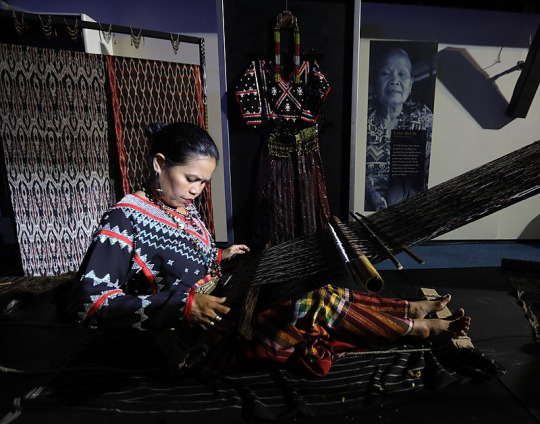
A Tboli woman weaving t'nalak from South Cotabato.
The Philippines is inhabited by more than 182 ethnolinguistic groups, many of which are classified as "Indigenous Peoples" under the country's Indigenous Peoples' Rights Act of 1997. Traditionally-Muslim peoples from the southernmost island group of Mindanao are usually categorized together as Moro peoples,
Architecture
Before the arrival of European colonizers, Austronesian architecture was the common form of housing on the archipelago.
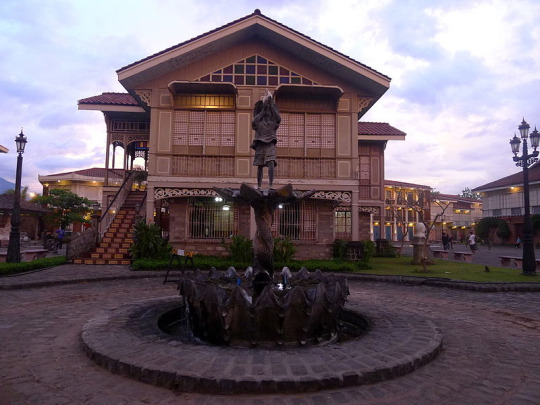
Bahay na bato, a traditional Filipino house
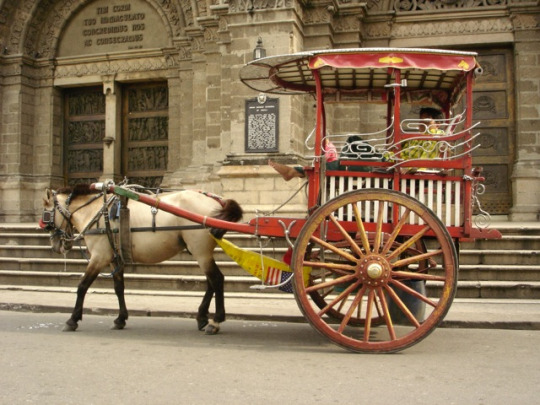
Kalesa, a traditional Philippine urban transportation, in front of Manila Cathedral entrance
During the Spanish era, the new Christianized lowland culture collectively evolved a new style known as the Nipa hut (Bahay Kubo). It is characterized by use of simple materials such as bamboo and coconut as the main sources of wood. Cogon grass, Nipa palm leaves and coconut fronds are used as roof thatching. Most primitive homes are built on stilts due to frequent flooding during the rainy seasons. Regional variations include the use of thicker, and denser roof thatching in mountain areas, or longer stilts on coastal areas particularly if the structure is built over water. The architecture of other indigenous peoples may be characterized by an angular wooden roofs, bamboo in place of leafy thatching and ornate wooden carvings. The Bahay na bato architecture is a variant of Nipa Hut that emerged during the Spanish era.
Traditional clothing
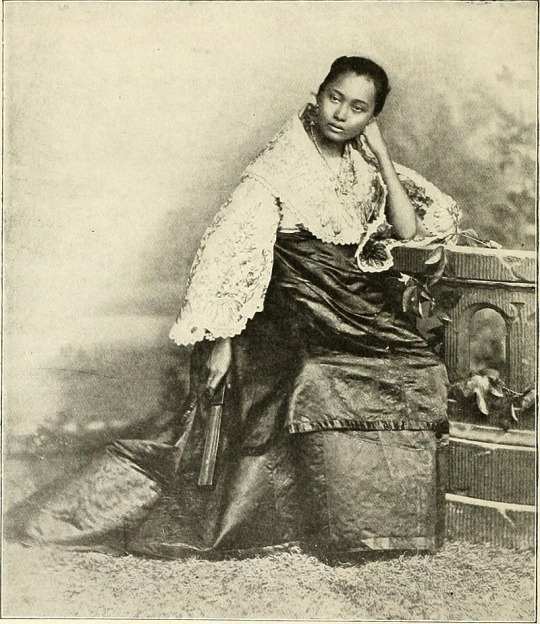
Filipina in traditional attire
Baro evolved from its forerunner garment worn by the Tagalogs of Luzon Prior to the Spanish Era. When the Spaniards came and settled into the islands, the fashion changed drastically as the Spanish culture influenced the succeeding centuries of Philippine history. The Spanish dissolved the kingdoms and united the country, resulting in a mixture of cultures from different ethnic groups of the conquered archipelago and Spanish culture. A new type of clothing called Barong tagalog (for men) and Baro't saya (for women) began to emerged and would ultimately define the newly formed Filipino culture....
Dancing

Filipino traditional dance at a festival
Philippine folk dances include the Tinikling and Cariñosa. In the southern region of Mindanao, Singkil is a popular dance showcasing the story of a prince and princess in the forest. Bamboo poles are arranged in a tic-tac-toe pattern in which the dancers exploit every position of these clashing poles
Music
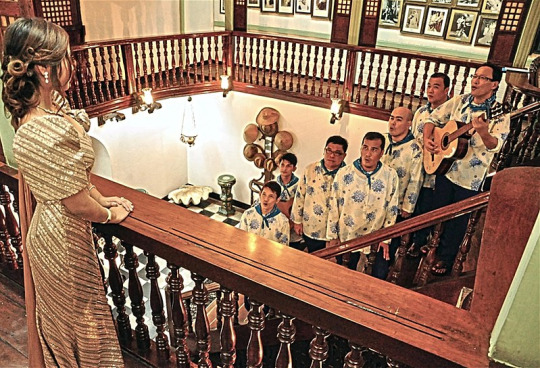
Harana (serenade)
The early music of the Philippines featured a mixture of Indigenous, Islamic and a variety of Asian sounds that flourished before the European and American colonization in the 16th and 20th centuries. Spanish settlers and Filipinos played a variety of musical instruments, including flutes, guitar, ukulele, violin, trumpets and drums. They performed songs and dances to celebrate festive occasions....
Folklore
Philippine mythologies are the first literature of the Philippines, usually passed on through generation via traditional and oral folk literature. Written texts recording the stories have also been made. These literary stories are mostly chanted as part of a dynamic Philippine epic poetry. While each unique ethnic group has its own stories and myths to tell, Hindu and Spanish influences can nonetheless be detected in many cases. Philippine mythology mostly consists of creation stories or stories about supernatural creatures, such as the aswang, the manananggal, the diwata/engkanto, and nature. Some popular figures from Philippine mythologies are Makiling, Lam-Ang, and the Sarimanok
Religion
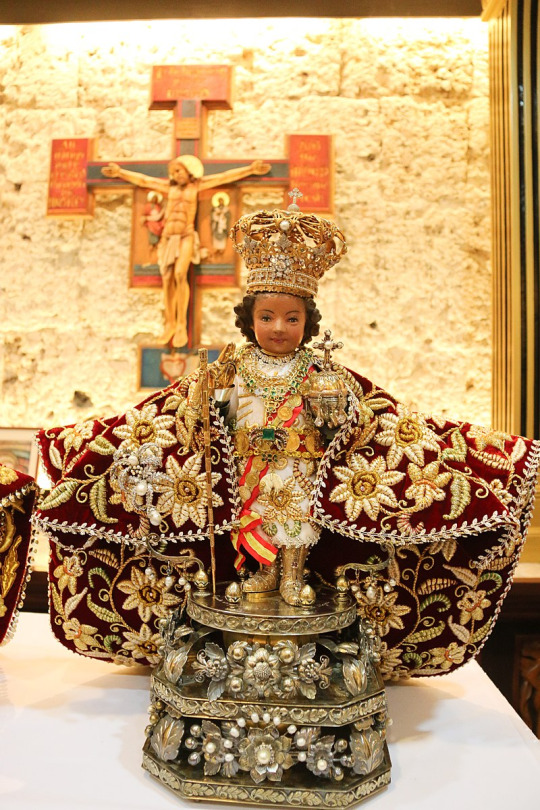
Original image of the Santo Niño de Cebú.
The arrival of the Spanish colonizers in the 16th century brought the beginning of the Christianization of the people in the Philippines. This phase in history is noted as the tipping point for the destruction of a variety of Anitist beliefs in the country, which were replaced by colonial belief systems that fitted the tastes of the Spanish, notably Christian beliefs. Christianity in form of has influenced Filipino culture in almost every facet, from visual arts, architecture, dance, and music. Presently, the Philippines is one of the two predominantly Catholic (80.58%) nations in Asia-Pacific, the other being East Timor. The country also has its own independent Philippine church, the Aglipayan, which accounts for around 2% of the national population. Other Christian churches are divided among a variety of Christian sects and cults. From the census in 2014, Christianity consisted of about 90.07% of the population and is largely present throughout the nation.....
Cuisine
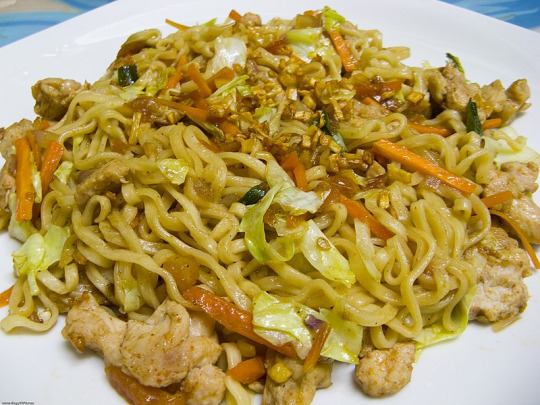
Pancit canton
Filipinos cook a variety of foods influenced by of main Indian, Chinese, influences indigenous ingredients. The Spanish colonizers and friars in the 16th century brought with them produce from the Americas such as chili peppers, tomatoes, corn, potatoes, and the method of sautéing with garlic and onions. Eating out is a favorite Filipino pastime. A typical Pinoy diet consists at most of six meals a day; breakfast, snacks, lunch, snacks, dinner, and again a midnight snack before going to sleep. Rice is a staple in the Filipino diet, and is usually eaten together with other dishes. Filipinos regularly use spoons together with forks and knives. Some also eat with their hands, especially in informal settings, and also Filipinos use chopsticks when eating seafood....
Festivals
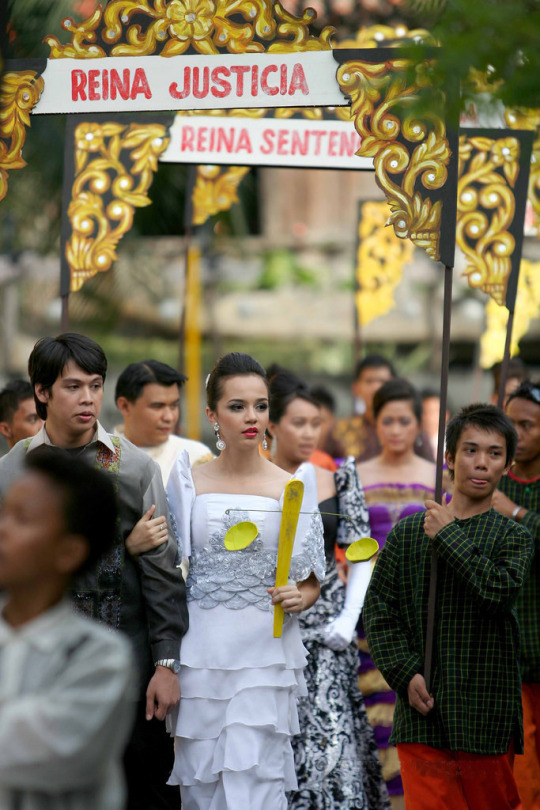
Flores de Mayo
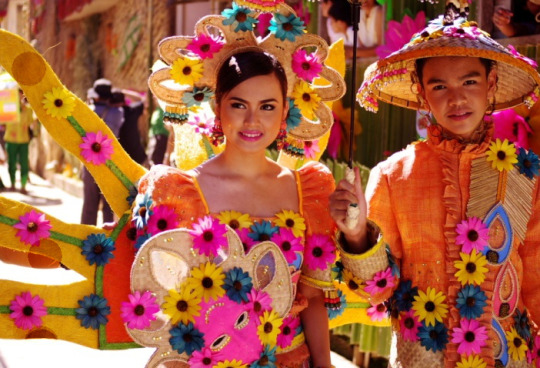
Pahiyas Festival in Lucban Quezon

The MassKara Festival of Bacolod.
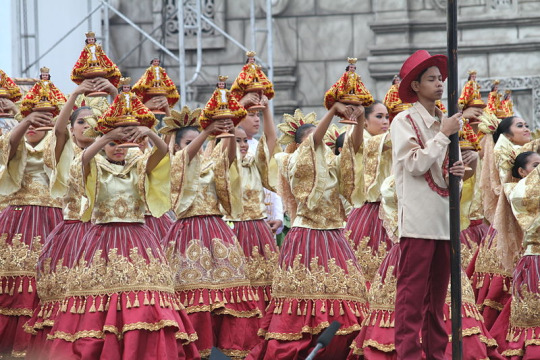
The Sinulog Festival is held to commemorate the Santo Niño
Festivals in the Philippines, locally known as fiestas, originated dating back to the Spanish colonial period when the Spaniards introduced Christianity to the country. Most Philippine towns and cities has a patron saint assigned to each of them. Fiestas in the Philippines serve as either religious, cultural, or both. These festivals are held to honor the patron saint or to commemorate history and culture, such as promoting local products and celebrate a bountiful harvest. Fiestas can be categorized by Holy Masses, processions, parades, theatrical play and reenactments, religious or cultural rituals, trade fairs, exhibits, concerts, pageants and various games and contests..
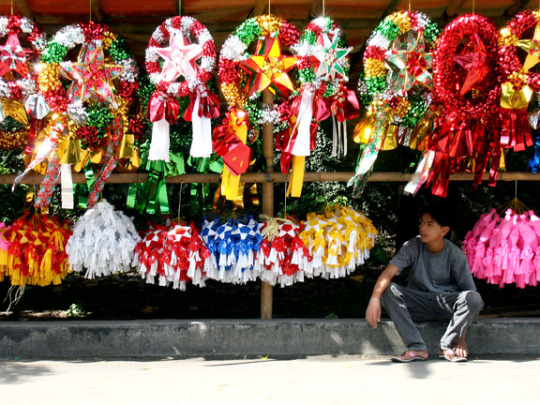
Parol (Christmas lanterns) being sold during the Christmas season

Good Friday observance in Pampanga
Heritage towns and cities
The Philippines is home to numerous heritage towns and cities, many of which have been intentionally destroyed by the Japanese through fire tactics in World War II and the Americans through bombings during the same war. After the war, the government of the Empire of Japan withheld from giving funds to the Philippines for the restoration of the heritage towns they destroyed, effectively destroying any chances of restoration since the pre-war Philippines' economy was devastated and had limited monetary supply. On the other hand, the United States gave minimal funding for only two of the hundreds of cities they destroyed, namely, Manila and Baguio....
Culture of the Philippines - Wikipedia
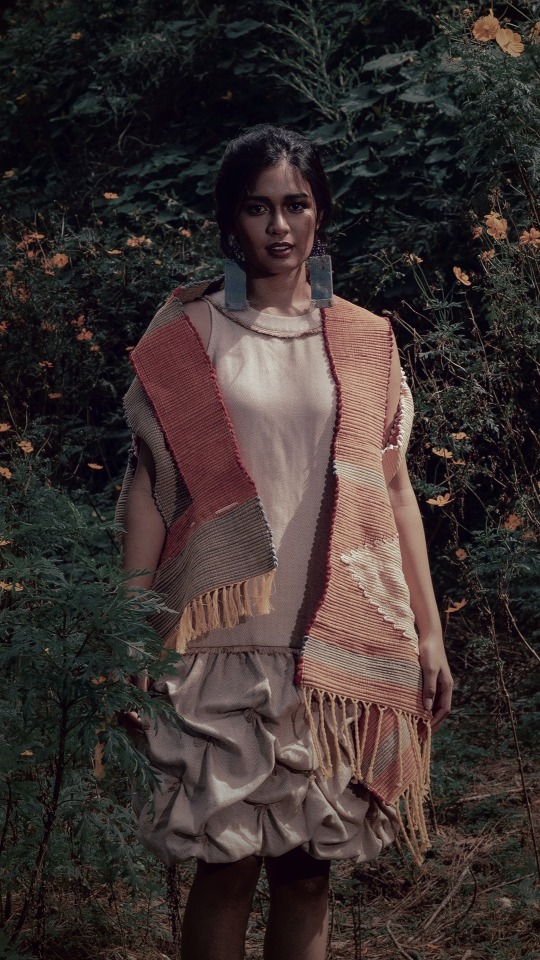
Ethnic Filipina in traditional costume
269 notes
·
View notes
Text
Customized Barong Tagalogs refer to the traditional Filipino formal attire known as the Barong Tagalog, which has been modified or tailored to suit individual preferences or specific occasions. Here are some ways customization can be applied to Barong Tagalogs:

Fabric Choice: Traditional Barongs are typically made from piña (pineapple fiber), jusi (silk blend), or similar lightweight materials. Customization can involve choosing a specific type of fabric that aligns with personal taste or the formality of the event.
Design Elements: Customization may include adding or modifying design elements such as embroidery patterns, accents like beads or sequins, or even incorporating modern motifs while still respecting the traditional silhouette and structure.
Fit and Cut: Tailoring the Barong Tagalog to fit perfectly can enhance its appearance and comfort. This includes adjustments to sleeve length, overall length, collar style, and the fit around the shoulders and torso.
Color Choices: While traditional Barongs are often in neutral tones like white or ecru, customization allows for a broader range of color choices. This can be particularly useful for themed weddings or events where specific colors are preferred.
Personalization: Adding personalized details such as monograms, initials, or even family crests can make the Barong Tagalog more meaningful and unique to the wearer.
Occasion-Specific Features: Depending on the event, customization can involve adding subtle details that reflect the occasion’s theme or cultural significance.
Accessories: Customization can extend beyond the Barong itself to include matching accessories like cufflinks, ties, or even a bespoke undershirt.
Customized Barong Tagalogs are a blend of tradition and personal expression, allowing individuals to honor Filipino heritage while reflecting their own style preferences and the specific requirements of the event they are attending.
#barongtagalog#philippines#barongs#philippine culture#custommadebarongtagalog#filipinopride#madeinthephilippines#filipinoculture#filipinowedding#pinoy
2 notes
·
View notes